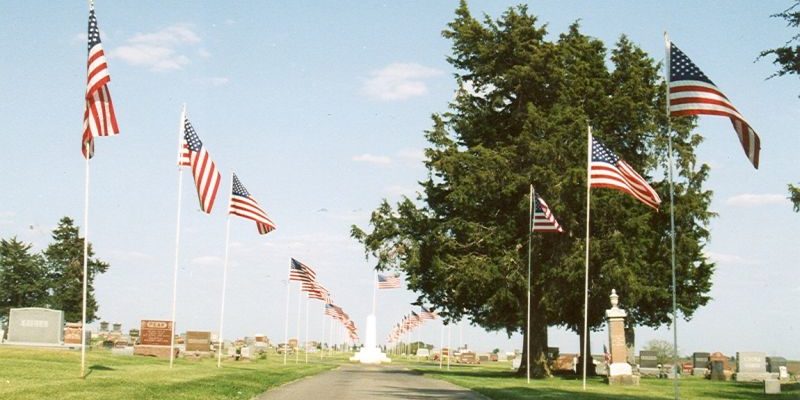The deed to the Rippey Cemetery is dated May 2, 1881. T. J. and Sedina Burns and P. M. and Emma A. McFarland conveyed to Washington Township for cemetery purposes, four acres, described as follows: Lot number 1 of SW quarter of SW quarter, Section 11, Township 82 N. Range 29. Consideration $100.00.
On April 5, 1909 J. A. and Elizabeth Chambers deeded two acres of land to J. M Parr, Simon Fouch and John Burk, trustees for Washington Township.
On May 23, 1934, Emeline Stiger and C. B. Stiger deeded a strip of land along the east side of the cemetery containing two acres, to the trustees of Washington Township for $300.00.
On October 17, 1968, two acres of new land was purchased by the Washington Township Trustees, from Albert Weston for $1,600.00. This is located on the North side of ther existing cemetery. The trustees at that time were Darwin Grow, Raymond Kenney, Merle Coon and Clerk, Hugo Norgren.
OLD RIPPEY
The ground for the “Old Rippey” Cemetery was deeded by Norman S. Daniels to the trustees of Washington Township on November 15, 1858, and described as follows: commencing 7 rods west of the southwest corner of the town of “Old Rippey” thence north 8 rods., thence west 16 rods, thence south 8 rods, thence back to place of beginning. Price–$2.00.
After the 60 inhabitants of Old Rippey moved to their new location, the cemetery became neglected, and grew full of weeds and shrubs. Several members of the Searchlight Club noted this and discussion among their group led to the restoration of this cemetery as their 1958-1960 Community Achievement Project. The account of this project is in the Rippey Public Library and also recounted in the 1970 HISTORY OF RIPPEY, GREENE COUNTY, IOWA, OLD RIPPEY AND NEW RIPPEY, 1849-1970, pgs. 85-87.
BOWERS/ANGUS
The Bowers/Angus Cemetery is located in southeastern Greene County, Section 36, six miles from Rippey, near Angus, which was formerly know as Coaltown. Angus began as a settlement in 1848. After the railroad was made and several large coal mines were in operation , Angus became a boom town and at one time the population was estimated to be 7,500 to 8,000 inhabitants.
This was the only cemetery Angus had. The early graves were unmarked and included many immigrants whose men folk worked in the mines. The earliest known burial was that of Miss Mary Wood in 1851. The most recent burial was for Jim Benshoof, who died March 19, 2002. Jim and his wife, Marge, were instrumental in the restoration project that started in April, 1961. The cemetery had become over-grown and uncared for. They continued caring for this cemetery until their health forced them to quit. Their son, Dan, is now the sexton.
The Washington Township Trustees are responsible for the care and upkeep of all these cemeteries. A tax is levied for this purpose. It is used to buy the equipment the sextons use to keep these cemeteries as nice as they are. We recently resurfaced the Rippey Cemetery and are trying to repair a few stones each year.
The trustees are:
- Chairman: Mary Hick
- Roger Norgren
- Tod Contner
- Jean Borgeson, Washington Township Clerk
- Sexton at Rippey: Roger Norgren
- Sexton at Bowers/Angus: Dick Bardole
Jean Borgeson was appointed by the Washington Trustees in January of 2000, to take over the recordkeeping of the cemeteries, replacing Myron Rinker, who had taken over for Clark Bardole in 1981.
Clark had taken care of the records since the mid 1930’s when he started working at the First National Bank. He told me that when he got the job, all the records were in a shoe box. He had a lady, who worked with him at the bank, try to make sense out of them and get them recorded into a book.
That is the same book that is being used now, and I can tell you, it is very interesting! I’m trying to get names and where the burials are, on a data base. He also told me not to let anyone bury someone without telling me. I guess that happened in the old days! Clark was very interesting to talk with. I loved his stories of the “olden days in Rippey”.

